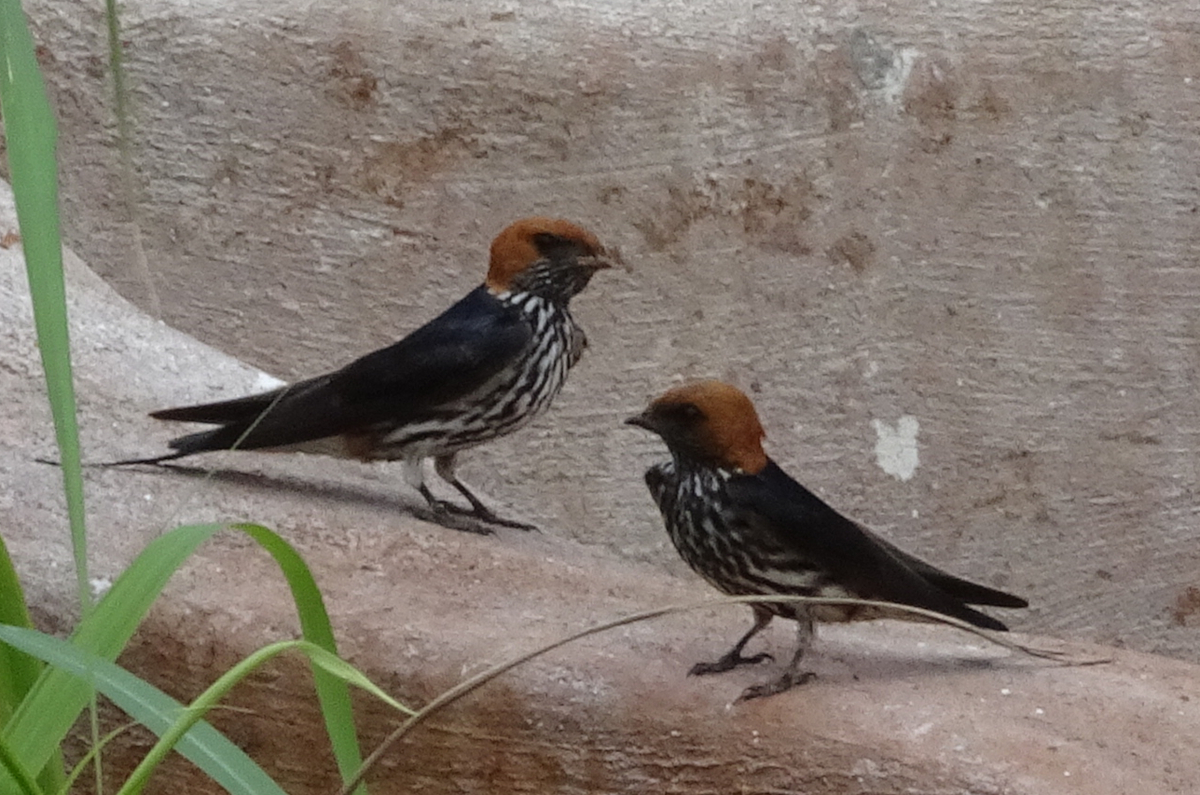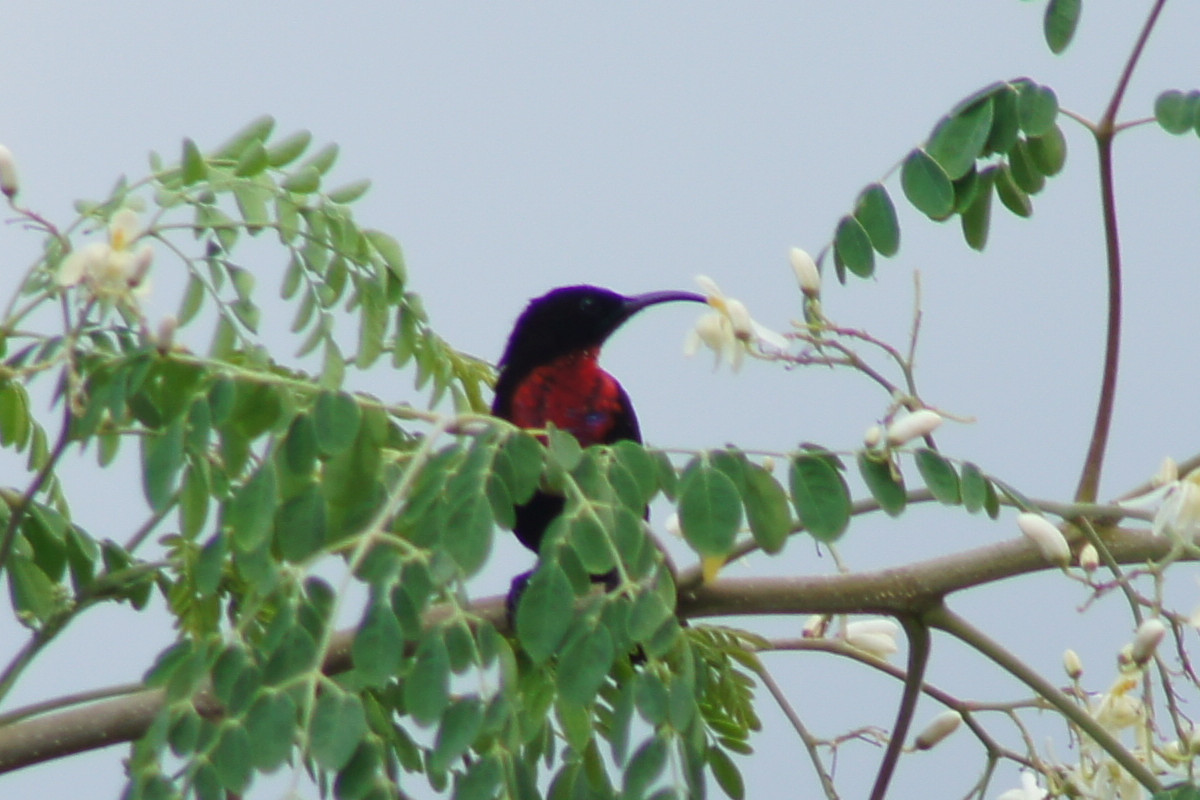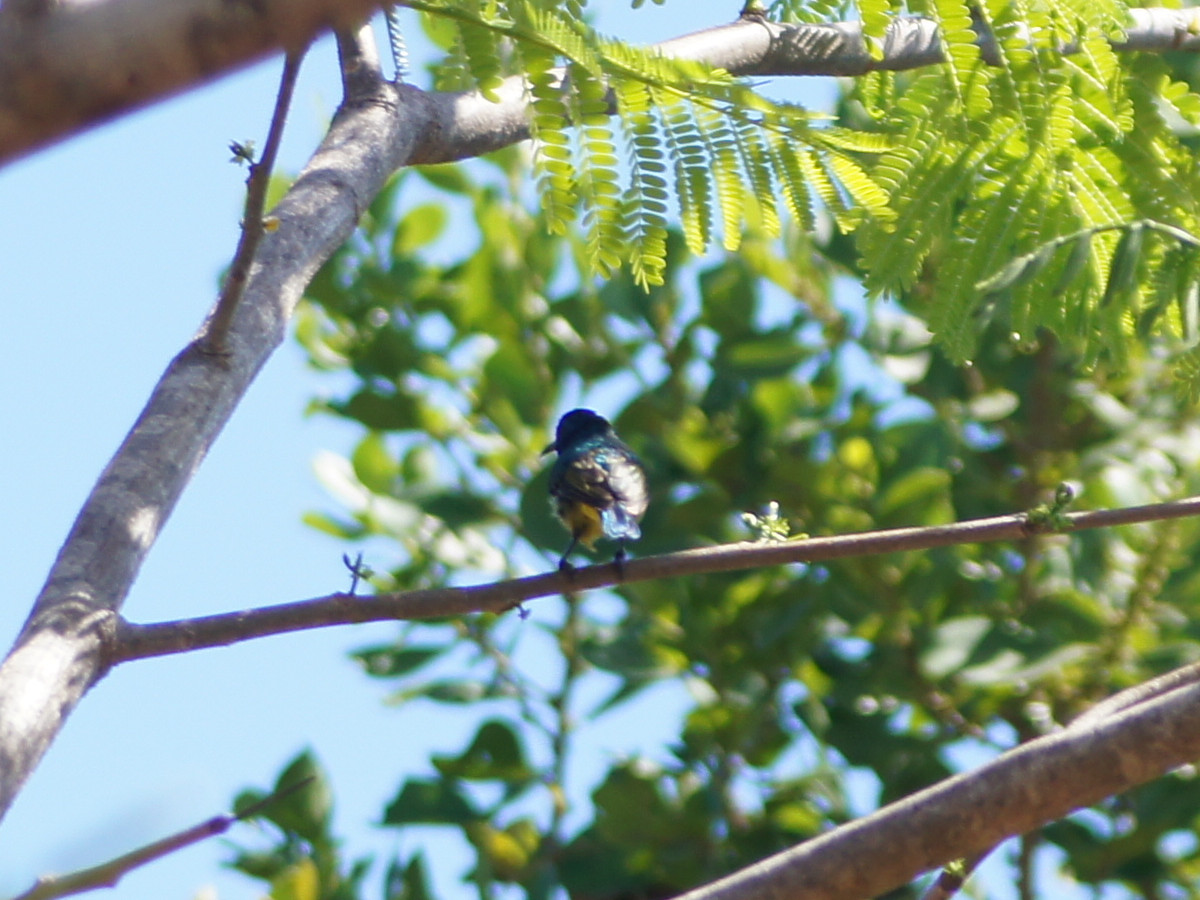KIZIMKAZI NATURE RESERVE FOR BIRDS
biodiversity is one of the biggest treasures of earth
In the fourth year of our project and with the help of our local community, the Garden of Wonders has taken shape.
In the spirit of the permaculture movement, we are moving forward - with some small but significant successes!
However, for some time now, the south of Unguja Island (Zanzibar) has also been changing. More and more bush land is being cleared to generate building land.
The bush land is however the last retreat for the already beleaguered native bird world.
Currently, a known problem throughout the archipelago is the invasive Indian Shining Crow.
These birds, which until now have been particularly active in the tourist mass quarters, eat everything that comes in front of their impressive beaks.
The predatory crows snatch the farmers' fruit from the trees. Worse still is the pressure on the remaining bird species, such as weaver birds and kingfishers, whose nests they raid, now also around Kizimkazi, in southern Zanzibar, which had previously been largely spared by the crows.
The harassed birds retreat even more strongly into the bush country, where they " still" find protected nest places. But scrubland also needs protection.
The government has officially tendered the land of about 4500m²as building land.
Since it is an important concern to us to contribute with our projects also to the diversity of species, we decided to acquire the bush land adjacent to our property and to have it designated as a nature reserve.
If the purchase comes about the area must be fenced in the short term with a natural stone wall, because the land is also threatened by free-roaming livestock and firewood extraction.
The cost will be about 15,000 $. I ask you for a donation for this small nature reserve in Kizimkazi Zanzibar.
The project will be carried out by the Garden of Wonders.
We already have the necessary infrastructure.
A new working group of species conservationists and "rangers" is being built up, or is already part of the team.
The Birdwatcherhouse with viewing platform will be available for guests.
How to create a sustainable operation
The Birdwatcherhouse with viewing platform will be available for guests.
Salaries for two local workers, who take care of the land, maintenance and care of the guests, are to be raised.
Just renting out the house for one night a week would cover the running costs. Money generated beyond the costs, also by further offers, in relation to the bird sanctuary are saved for a long-lasting existence.
BIRDS OF THE GARDEN OF WONDERS
The following birds have been seen in the bird paradise. We have determined them with the greatest care. Should you nevertheless discover discrepancies and want to share your knowledge with us, please contact us:
birds@garden-of-wonders.org
We also value correct information and look forward to every suggestion and discussion.
AFRICAN PYGMY KINGFISHER

We saw this african pygmy king fisher around lunch time. It was patching so close to us in the bush. We were so happy about this beautiful view.
It is the smallest bird in his family.
This bird likes to be in thick bushes and they are more quit than the other kind of there species. Most of the time they are solitary.
YELLOW VENTED BULBUL

The yellow vented bulbul is a very chatty busy bird with yellow colour under their tail. It often hop around branches or on the ground seaching for food. It bounce and hop even faster and call where they approching danger like snakes , leopards,and owls. The song of the bulbul is a warning signal for other animals and even humans.
It eats a lot of fruits, nectar and seeds, therefore very impontant for plants, for spreading their seeds.
AFRICAN GOLDEN WEAVER

The african golden weaver is an easily spotting bird, because they are more seen in lager frock, busy building there nest. They are more seen in open areas with long trees like palm trees.
Until two year a go you could find a lot them at the beach of kizimkazi. Did they moved due the pressure of craw?
Local people call them mnana, that is their swahili name.
ZANZIBAR SOMBRE GREENBULL

The zanzibar sombre greenbul is very common in the bird reserve of the garden of wonder. You can easily hear the voice from early morning to late evening. It is very hard to spot them, due to their color is matching with the green leaves.
It was around 5:30pm. We were sitting quietly on the terrace, when I got the chance to see this bird. It was out of the bush and patching close where we were. We managed take that picture, which was amazing for us.
RED CAPPED ROBIN CHAT

The red capped robin chat is an intro African migrant bird. It is moving from country to another country depending on the season of the year.
This bird is a master of singing because it can mimic calls from other birds also examples like a call of slate coured boubou. The Red capped robin chat is so shy and not easy to spot. Just sometimes, if you a lucky, you can spot them in the late evening taking a sunbath.
GREATER BLUE EARED STARLING

The greater blue eared starling, a bird that lives in woodland and tall trees area, was now found in the thick bushland, what is not a usual habitat for them, close to a village called kizimkazi in unguja zanzibar.
This is because the people in this village are cutting down trees and sell the plots for building houses and lodges. This makes birds to surffer due loosing their habitat.
Let us come together and protect our nature.
SCARLET CHESTED SUNBIRD

The color of the plumage on the body gives the scarlet chested sun bird its name. The colour is presented by the male which has shine black colour on its back part and scaret on the brest or chest, and the female is brown or colourless and little strips under the brest.
The name sun bird comes from the glow when the light of the sun falls directly on its feathers. It is a breathtaking sight when the colors come into their own. In the shade, the colors of this bird are rather inconspicuous.
SRIPED SWALLOW

They are not common in the Garden of Wonders. Still, striped swallow can sometimes be found there. They are friendly birds that can get close to humans. Unlike other birds, they use grasses for nesting.
They live in pairs of males and females. In Bustani ya maajabu I saw them several times coming to the pool to fetch water.
HOUSE SPARROW

The house sparrow is not a rare bird. Nevertheless, he belongs to the domestic species of birds. They come as a group and take their part from the pet fressnotta.
CHATTERING YELLOWBILL

chattering yellowbill
BEARDED SCRUB ROBIN

In Kizimkazi bird reserve they are also master of song like the robin chat . this one is not shy bird compare to chat family, wich are more hiding. The beaeded scrub robin is often patching on top of trees especially in the evening for sun bathing or jumping on the ground looking for some food like seeds and insect.
They sing different kind of calls and even mimic calls from other birds like the yellow vented bulbul.
EURASIAN GOLDEN ORIOLE

Common people call the eurasian golden oriole banana bird ,due its bright yellow, which is carred by the male. The wings are black.
The eurasian golden oriole is easy to identify, especially during breeding season. By then they are even more intenive bright yellow. It took me a long time recognise tis species, because there was two immature which look different to the adult. Their lump and vent was yellow. The under part from the throat to the belly was white and had small strips. I did not think of that they are caming from oriole family especially not from the banana oriole.
SPOTTED FLYCATCHER

When saw the spotted flycatcher in garden of wounder, I was thinking it is the female sparrow. After concentrated looking, I saw the differences! Spotted flycatcher have small stripes from the breast and more grey color than the house sparrow which is just greysh.
The flycatcher got its name due to its ability of catching a prey, like flies and other insect, even when it is flying.
COLLARED SUNBIRD

It was a nice moment in the garden of wonders, next to the makuti house, when this beautiful small bird was coming to the flametree to start eating from the flowers. After a time the collared sunbird started producing a call and the female was joining. I could see due the difference of its colors.
EASTERN GREEN TINKERBIRD

The eastern green tinkerbird is second kind of tinkerbird I have seen in east africa, tanzania, after only seeing a red fronted tinker bird.
It was wonderful morning, here the garden of wonders, to see this eastern green tinkerbird, patching on the pole and holding an insect. I was slowly followig it. It was flying to a pol going inside of a hole which was in the otherside of this pole and I heard the sound of the chicks react to the parent brought some food .now I regonize these was a nest of this bird I managed to make a picture as you can see… is taken inside the garden of wounders.
DARK BACKED WEAVER

The dark backed weaver is another species of bird found in the garden of wonders in the Kizimkazi Bird Sanctuary. They can sometimes only be seen 2 in a small flock of 4 to 6. They usually live in forest areas, but often come close to human settlers.
They are known as dark-backed weavers because of their body color. As weavers, they weave their nests in a very special way.
INDIAN HOUSE CROW

Unfortunately you can hear the calls of the indian house crow at any time during the day.
They are the largest of all types of birds that we have seen so far in Bustani and all of Zanziar.
Crows are "ormnivores", they eat all kinds of food; Fruits, vegetables, meat and seeds. In addition, the crows are also scavengers, feeding them on human food scraps. As an inversive species on Zanzibar, they destroy and plunder nests of the native bird species.
WHITE BROWED COUCAL

The white browed coucal like to hide under thick bushes. They also can swim. After you can watch them spread their wings and tails for drying.
When they are hunting they drop into cover and climber adeptly through vegetation or runs along ground.
Sometimes they can carry their nest held between its thighs while flying. The white browed coucal eats variety of animals prey includes, bittles, grasshopers, crabs, snails, even nestling birds up to dove size.
MADAGASCAR BEE EATER
The madagascar bee eater are called according to their unussal diet, they eat bees like a special food , and catch bees and press the abdome of the bee to release the sting before they swallow , so the bees will not stang them on their throat when they swallow.
BRONZE MANINKIN
The bronze maninkin are very social birds. They build a big nest and live in it for many of them. During the nest building they are very busy collecting dry grass.
These birds are extremely noisy when predators are around, especially when animals are under their nest.
The Gogo Trible, who live in central Tanzania in the Dodoma region, therefore like to build a stable for their cattle under the tree that has a nest for these birds. At night, when hyenas and lions try to approach to attack the cattle, the bronze maninkin proclaim the herders.
green backed camoroptera
emerled spoted wood dove
This birds are not confirmed jet
They still need to be identified fore shure
-grey backed camaroptela
-dove
-hornbill
-apalis( yellow breasted apalis)
-dedric cuckoo
-starling(greater blue eared starling)













